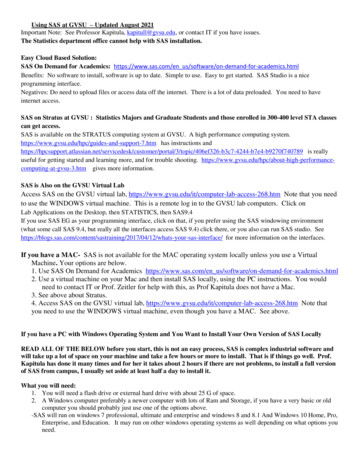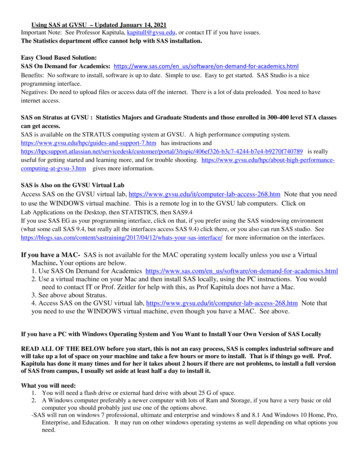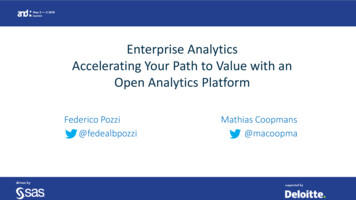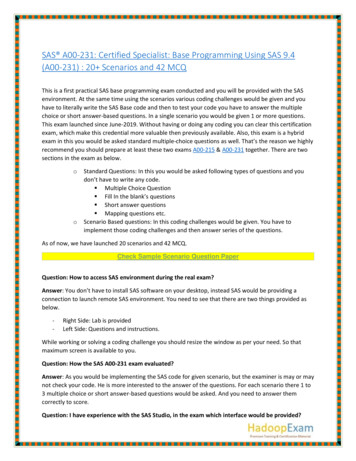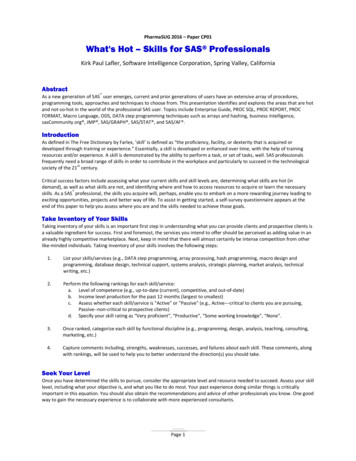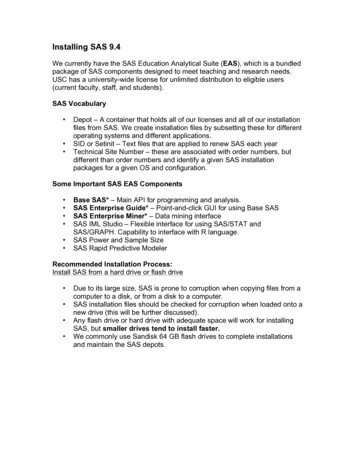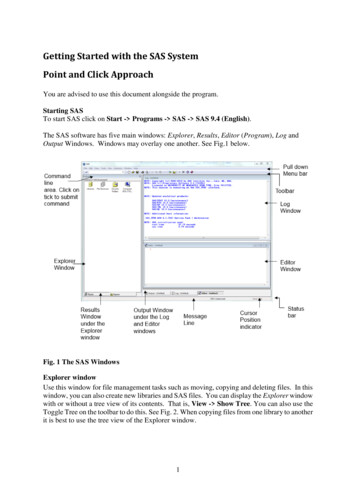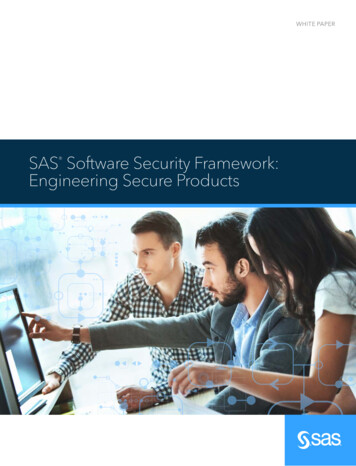
Transcription
WHITE PAPERSASSoftwareSecurityFramework:TitleEngineering Secure Products
iiContentsSAS Software Security Policy. 1Secure architecture and design. 2Secure scanning and auditing pipeline automation. 3Application security education and engagement. 4Secure development. 5Security testing and validation. 6Product security response and remediation. 7You can count on SAS. 7
1SAS builds quality software that is secure and privacy-preserving. Our products are builtto be resistant to misuse and known cybersecurity threats. SAS guides its architects anddevelopers based on our software security framework (see Figure 1). At the highestlevel of the framework, we have defined a software security policy structure thatsupports product security governance. This model applies to each phase of a product’ssoftware development life cycle (SDLC).SAS Software Security PolicyQuality and ComplianceSecure DesignImplementationSecurity Testingand VerficationIncident ManagementProject Level SecurityReview ProcessProduct CryptographyStandardThird-Party SoftwareRequest ProcessProduct SecurityTesting StandardProduct Security VulnerabilityRemediation StandardSecurity Exception ProcessSecure DesignReview ProcedureQuarterly Security UpdatesProgramThird-Party PenetrationTesting ProcedureProduct Security IncidentResponse Team ProcedureApplication Security Testing,Awareness and CultureThreat Modeling ProcedureSecure Scanning and AuditingPipeline AutomationBug Bounty andBug Bash ProgramSecurity Ticket Tracking andRemediation Guidelines forProject ManagementFigure 1: The SAS Software Security Framework.SAS Software Security PolicySecure software development is governed by the Product Security Office of the SASR&D division. Its mandate is to develop application security policies, secure architecturedesign patterns and enable software development teams to meet and exceed ourstandard of excellence.In developing SAS policy, we incorporate industry best practices and standards developed by the US National Institute of Standards and Technology (NIST), the InternationalStandards Organization and the Open Web Application Security Project (OWASP). Thestructure of our policy reflects the technical requirements of these organizations withthe intent of informing our software engineers of product security requirements, whichultimately empowers our customers in their own compliance journey.Compliance with our software security policy, standards and processes is required byall R&D product teams, including teams within R&D divisions that reside in individuallines of business (LOBs).
2Our policy includes: Reviewing all open source code for licensing and known security vulnerabilities(using software composition analysis tools) before integration with SASproduct code. Ensuring that SAS product teams conduct software composition analysis, staticanalysis security testing and dynamic application security testing. Tracking and remediating product security vulnerabilities that are reported bycustomers and found during internal assessments and testing.Typical application security controls that are incorporated into our software includeallowable encryption algorithm and cipher suite specification, authentication andauthorization mechanisms, audit controls, error handling and session management.SAS provides engineering teams with clear procedures and detailed guidelines forsecure coding and testing to help ensure compliance with the SAS Software SecurityPolicy. Additionally, teams are provided with procedures, guidance and security expertconsultation support for secure architecture design and threat modeling for new SASproducts and features.Secure architecture and designThe SAS Platform uses a security architecture that provides strong authentication,authorization, confidentiality, availability and data integrity. We achieve a secureand reliable architecture by designing to industry standards through a secure-bydesign philosophy.Our engineers are empowered to review solution architectures and software code toquickly identify and resolve potential security weaknesses using advanced techniquessuch as application threat modeling. Our platform services receive thorough threatmodeling and secure design reviews, and all R&D product teams are encouragedto utilize those services. Our Product Security Office has developed a secure designreview procedure and a threat modeling program to ensure that product teams arewell resourced to represent security in the design phase of products and features.Threat modeling also enables SAS software testers with prior knowledge of possibleattack vectors and challenges them to test and validate any design assumption beforeimplementation. SAS relies upon industry-standard application security risk taxonomies(e.g., CWE and CAPEC) to conduct product security evaluations. Our goal with threatmodeling is to identify the software defects that the application code scanners cannotto secure the design at run time.Lastly, we complement our secure-by-design philosophy with an engineering productlevel security review process to ensure that each product has supporting internaldocumentation (i.e., objective evidence) on how it passed each of the requirementscontained in our software security policy.
3Secure scanning and auditingpipeline automationTo increase efficiency and accuracy in our CI/CD workflow, SAS has developed automated scanning within our release pipeline to capture audit records of security scanresults in real time. This enhances our ability to catch and correct any vulnerabilitiesor flaws early in the software development cycle, increasing the likelihood that wecan secure our latest releases against common vulnerabilities and exposures (CVEs)that may have been reported only hours before.AliceSAST ScanningUsersLook for first-partycode vulnerabilitiesDeveloperDAST ScanningLook for run-timevulnerabilities inweb apps/APIsPlanDesignBuildTestReviewReleaseSCA ScanningSecure Development Life CycleLocal Development ProcessLook for third-partylibrary vulnerabilities
4Application security educationand engagementAt SAS, every employee plays an important role in keeping SAS software securefrom threats.Security ResponsibilitiesPSOOrg StrategySecurity LeadsDivisional ngineersProduct security leads and security champions support the Product Security Office(PSO) in building security culture by stressing the importance of security within theirdivisions and modeling good security practices. The PSO sets strategy and initiatives at an organizational level. Product security leads determine how to lead the strategic implementation of theinitiatives for their division. The product security lead also recommends solutionsand contributes back to the PSO. Security champions run and review scans during development and perform securityduties for their team(s). Working alongside and actively engaging team members in their divisions,product security leads and champions educate and guide team members, givingthem the knowledge and resources they need to design, develop and deploysecure software. Project managers plan, scope, monitor and control security work and remediationthroughout the software development life cycle and ensure that the product teamtakes responsibility for incorporating security work into their dev and test cycles.In the spirit of inclusion, all of SAS’ security and compliance divisions participatein organizing cybersecurity awareness events and knowledge sharing sessionsthroughout the year. Our security culture includes regular online development forumengagement, blog topics, monthly open forums and on-campus educational events.
5As part of R&D’s security assurance program, the Product Security Office organizesethical hacking events, such as Capture the Flag, Bug Bounties and Bug Bashes,designed to increase employee participation, engagement and education, as well asbenefit the software and documentation by logging and correcting issues found duringthe events.SAS provides its employees with access to application security training resourcesthat can be customized into a learning plan according to their role or their need tocomplete a specific security standard-related task. Within R&D, the Product SecurityOffice and security associates regularly offer a variety of internal training sessions ontrending topics, such as open forums, secure architecture design and demonstrationsof new security tools and upgrades.Security training is delivered through a variety of mediums, including: Our central corporate learning management system (LMS) that requires mandatorysecurity training and includes self-paced e-learning, instructor-led workshops andlabs, and a complete virtual learning environment with access to SAS software. Third-party subscriptions to advanced application security coaching modules withindevelopment environments. These help software developers detect and resolvecommon weaknesses and exposures in real time as they are writing code. Advanced security training courses offered throughout the year to ensuresoftware life cycle practitioners’ skills are current with the cutting edge ofprofessional standards.Secure developmentSAS engineers design and build software according to industry best practices forsecure coding and open protocol standards for secure authentication and networkcommunication. At each phase of the secure SDLC, we ensure that engineers prioritizethe development and testing of functional and nonfunctional security requirements.We have also implemented automated checks in our release pipeline to ensure thatall shipping code includes required security updates.We build and test our products against accepted industry guidance: OWASP Top Ten Project. National Institute of Standards and Technology (NIST). International Organization of Standardization (ISO). Center for Internet Security (CIS). Microsoft Security Development Lifecycle (SDL). SEI CERT Secure Coding Standards. Common Weakness Enumeration (CWE). Internet Engineering Task Force Standards. OWASP Software Assurance Maturity Model. Common Attack Pattern Enumeration and Classification (CAPEC). Common Vulnerability Scoring System (CVSS).
6SAS engineers work in trusted and secure development and build environments, whichare centrally monitored and maintained by our global IT service delivery and supportdivision. All development build systems and release pipelines are secure and onlyaccessible to those who have a legitimate and authorized need for access. For moredetails on our build process, please refer to the SAS Quality Imperative white paper.Security testing and validationContinuous security testing is an integral part of the SAS Software Security Framework.SAS employs a customized suite of security tests specific to the range of available SAStechnologies. Depending on the type of product, the security tests can include exploitation of OWASP Top Ten weaknesses, CWEs, CVEs, encryption mechanisms, errorhandling, input handling and application programming interface security. SAS makesextensive use of commercial and open source tools for: Software composition analysis (SCA). Static application security testing (SAST). Dynamic application security testing (DAST).We are continuously improving and automating the process of monitoring the qualityof our code as it moves from development to build to release environments to ensurethat it is following our software security policy before and after release. Each type ofcode scan (i.e., SCA, SAST and DAST) is performed by trained engineers to identify,confirm and remediate software weaknesses as they are found at different phasesof the SDLC.Within R&D, we have adopted ethical hacking techniques to perform internal penetration testing during our bug bounties and bug bashes. Internal penetration testersexercise business logic and workflows that may not be captured by conventionalscanning software tools to supplement our automated scanning practices.SAS also engages third parties to perform independent security assessments andpenetration testing on our software products to determine their resiliency to attackand misuse. Specially constructed virtual environments are used to simulate customerdeployments in the cloud and on-site.If weaknesses are identified in product or architecture deployments, then they areentered into a defect tracking system and worked to resolution against our productsecurity vulnerability remediation standard. Importantly, SAS considers all productsecurity testing tools, methods, models and results to be company confidential, andtherefore details cannot be disclosed.It is not uncommon for SAS to respond to our customers’ security and internalaudit teams to verify the results of their own security testing. SAS technical support(support.sas.com) works with organizations to understand the significance andimpact to environments pertaining to any findings. We are committed to ensuringthe successful and secure deployment of SAS products.
7Product security response and remediationSAS is a proud member of the Forum of Incident Response and Security Teams (FIRST).We are committed to responsible reporting of security incidents and managing vulnerabilities identified in our software and integrated third-party components.The SAS product security incident response team (PSIRT) is responsible for workingwith SAS technical support, customers and industry partners to create an informedunderstanding of the applicability, severity and impact that a security finding mayhave and then complete any remediation.Customers who have a valid SAS support contract should report suspected securityissues by opening a track with SAS technical support. Security researchers or otherswho do not have a support contract can contact the SAS PSIRT directly by sendingemail to psirt@sas.com. Information about security vulnerabilities should be encryptedby using our PGP public key.The SAS PSIRT process includes a structured approach to program management andvulnerability scoring as it applies to both investigating vulnerabilities and remediatingthem according to the requirements of the SAS Software Security Policy. Often thescope of vulnerabilities can be cross-divisional, and the PSIRT acts as the designatedresponder for SAS product security incidents.SAS provides the following public communication channels to disseminate securityrelated announcements: SAS security bulletins. Downloads and hot fixes. SAS Notes with security vulnerabilities. Communities: SAS Hot Fix Announcements.The security bulletins page provides official SAS statements and advisories on theapplicability of major CVE announcements and our recommended resolution. SASNotes provide in-depth analysis of vulnerabilities and a cross-reference to SAS productrelease fixes, which are communicated through SAS user communities.By following the SAS Hot Fix Announcements, customers can receive real-time notifications of software upgrades, fixes and, when applicable, recommended configurationchanges. The security bulletins page also includes special topics such as Java support.Note that for Viya releases beginning with Viya 2020.1, patch updates are providedinstead of hot fixes.You can count on SASOur solutions and their deployments are complex and highly adaptable to the security configuration requirements of our customers. We have integrated industry best practices for software vulnerability detectionthroughout each phase of our secure SDLC. We also employ advanced threat modeling techniques duringdesign and operations phases to continuously analyze and improve the resiliency of our software against today’semerging cybersecurity threats. SAS is committed to delivering and maintaining secure analytics solutions.
For more information, please visit: sas.com/trustSAS and all other SAS Institute Inc. product or service names are registered trademarks or trademarks of SAS Institute Inc. in the USA and other countries. indicates USA registration. Other brand and product names are trademarks of their respective companies. Copyright 2021, SAS Institute Inc.All rights reserved. 107607 G188896.0921
Secure development SAS engineers design and build software according to industry best practices for secure coding and open protocol standards for secure authentication and network communication. At each phase of the secure SDLC, we ensure that engineers prioritize the development and testing of functional and nonfunctional security requirements.
